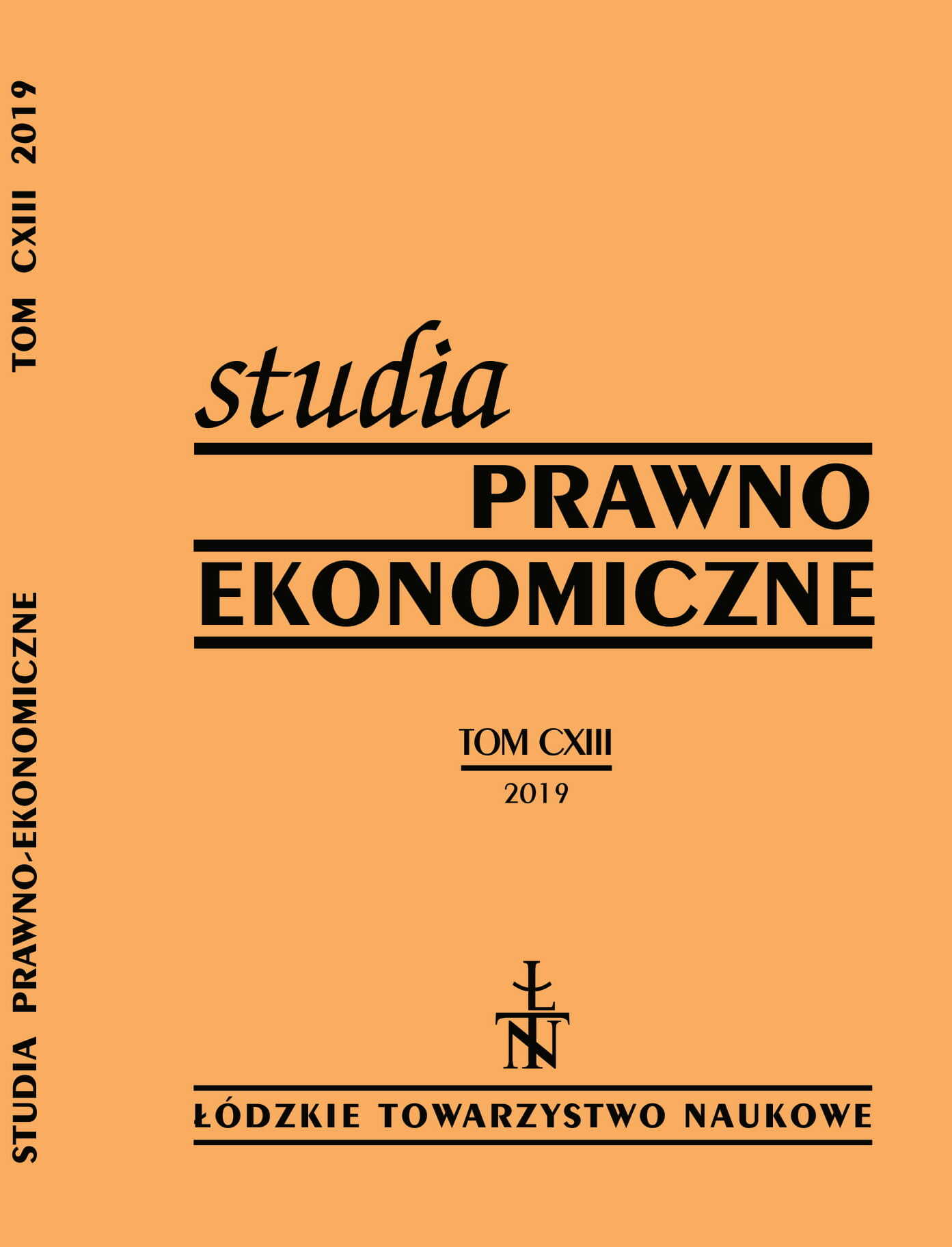Calendar effects on the alternative markets in Warsaw and London
DOI:
https://doi.org/10.26485/SPE/2019/113/18Keywords:
behavioral finance, alternative markets, seasonal anomalies, the effect of the month, GARCH modelsAbstract
Background: Research on behavioral theory has shown the presence of calendar effects on the stock markets, which are an exception to the effective market hypothesis. In the literature, the problem of calendar anomalies has not yet been examined in relation to alternative markets. The research and literature suggests that calendar anomalies concern mainly small companies; therefore this paper focuses on alternative market indices, which include small capitalization companies.
Research purpose: The main aim of this paper is to analyze calendar anomalies, i.e., the month of the year effect, the day of a week effect, and the turn of the month effect on two alternative investment markets: NewConnet (Poland) and Alternative Investment Market (Great Britain).
Methods: The article describes the results carried out using OLS regression models and GARCH models.
Conclusions: The results indicate that calendar effects appear on the alternative markets both in Poland and Great Britain. Both markets have a weekend effect, i.e., Monday’s and Friday’s rates of return are statistically significantly different from zero. In both markets, the month of the year effect was observed, as well as positive rates of return in the last sessions of the month.
Downloads
References
Ustawa z 29 lipca 2005 r. o obrocie instrumentami finansowymi, t.j. Dz.U. z 2018 r., poz. 2286.
Bollerslev Tim, Generalized Autoregressive Conditional Heteroscedasticity, Journal of Econometrics 1986/31, s. 307–327.
Bollerslev Tim, Engle Robert, Nelson Daniel, ARCH Models, w: Robert Engle, Dan McFadden (eds.), Handbook of Econometrics 1994/IV, Elsevier Science, Amsterdam, s. 2959–3038.
Brzeszczyński Janusz, Kelm Robert, Ekonometryczne modele rynków finansowych, Wydawnictwo WIG-Press, Warszawa 2002.
Czerwonka Monika, Gorlewski Bartłomiej, Finanse behawioralne: Zachowania inwestorów i rynku, Oficyna Wydawnicza Szkoła Główna Handlowa, Warszawa 2012.
Dudek Mieczysław, Wasylkowska Magdalena, Znaczenie naśladownictwa w rozwoju rynków kapitałowych, Zeszyty Naukowe Uniwersytetu Szczecińskiego 2011/37, s. 403–414.
Engle Robert, Autoregressive Conditional Heteroscedasticity with Estimates of the Variance of United Kingdom Inflation, Econometrica 1982/50, s. 987–1007.
Fama Eugene F., Efficient capital markets: A review of theory and empirical work, Journal of Finance 1970/25/2, s. 383–417.
Fama Eugene F., French Kenneth, Multifactor explanations of asset pricing anomalies, Journal of Finance 1996/51/1, s. 55–84.
Feder-Sempach Ewa, Rynki alternatywne w strefie euro i Unii Europejskiej a NewConnect – analiza porównawcza, Folia Oeconomica 2010/238, Wydawnictwo Uniwersytetu Łódzkiego, Łódź.
Fiszeder Piotr, Kożuchowska Justyna, Testowanie występowania wybranych anomalii kalendarzowych na GPW w Warszawie. Zastosowanie metod ilościowych w zarządzaniu ryzykiem działalności inwestycyjnej, Prace Naukowe AE w Katowicach 2013, s. 217–229.
French Kenneth R., Stock returns and the Weekend Effect, Journal of Finance 2000/39/1, s. 57–75.
Gajdka Jerzy, Behawioralne finanse przedsiębiorstw, Wydawnictwo Uniwersytetu Łódzkiego, Łódź 2013.
Grotowski Michał, Efekty kalendarzowe na Giełdzie Papierów Wartościowych w Warszawie, Gospodarka Narodowa 2008/1–2, s. 55–75.
Gu Anthony Y., The Declining January Effect: Evidences from the U.S. Equity Markets, Quarterly Review of Economics and Finance 2003/43/2, s. 395–404.
Gultkein Mustafa, Stock Market Seasonality: International Evidence, Journal of Finance and Economics 1983/12/4, s. 469–481.
Higgins Eric, Howton Shawn, Perfect Shelly, The impact of the day of the week effect on returns autocorrelation and cross-correlation, The Quarterly Journal of Business and Finance 2000/5/1, s. 57–67.
Hull Robert, Mazachek Juli A., Ockree Kanalis, Firm size, common stock offerings announcements period returns, The Quarterly Journal of Business and Economics 1998/37/3, s. 8–20.
Jacobsen Bouman, Zhang Cherry Y., Are monthly seasonals real? A three century perspective, Review of Finance 2013/17 (5), s. 1743–1785.
Jones Charles P., Investments. Analysis and management, John Willey & Sons, New York 1996, s. 282.
Kinnney William, Rozeff Michael, Capital Market Seasonality: The Case of stock returns, Journal of Financial Economics 1976/3/4, s. 379–402.
Kiyoshi Kato, Seasonal and Size Anomalies in the Japanese Stock Market, Journal of Financial and Quantitative Analysis 1985/20/2, s. 243–260.
Lakonishok Josef, Smidt Seymour, Are Seasonal Anomalies Real? A Ninety-Year Perspective, Review of Financial Studies 1988/1(4), s. 403–425.
Lizińska Joanna, Anomalie rynkowe na polskim rynku kapitałowym w ujęciu empirycznym, Finanse, Rynki Finansowe, Ubezpieczenia 2018/92(2), s. 269–279.
Mahdian Seyed, Perry Mark J., Anomalies in Us equity markets: a re-examination of the January effect, Applied Financial Economics 2002/12/2, s. 141–145.
McGroarty Frank, Urquhart Andrew, Calendar Effects, Market Conditions and the Adaptive Market Hypothesis: Evidence from Long-Run U.S. Data, International Review of Financial Analysis 2014/35, s. 154–166.
Mills Terrence C., Coutts Andrew J., Calendar effects in the London Stock Exchange FT–SE indices, The European Journal of Finance 2006/1:1, s. 79–93.
Peters Edgar E., Teoria chaosu, a rynki kapitałowe, WIG-Press, Warszawa 1997.
Reinganum Marc, Shapiro Alan, Taxes and Stock Market Seasonality: Evidence from the London Stock Exchange, Journal of Business 1987/60/2, s. 281–295.
Sierpińska Agata, Sierpińska Maria, Analiza porównawcza alternatywnych systemów obrotu giełdowego, w: Piotr Szczepankowski (red.), Zarządzanie finansami we współczesnych przedsiębiorstwach. Finansowanie i działalność inwestycyjna przedsiębiorstw, Vizja Press & IT, Warszawa 2009.
Smirlock Michael, Starks Laura, Day of the week and intradayeffects in stockreturns, Journal of Financial Economics 1998, s. 197–210.
Szyszka Adam, Finanse behawioralne: Nowe podejście do inwestowanie na rynku kapitałowym, Wydawnictwo Uniwersytetu Ekonomicznego w Poznaniu, Poznań 2009.
Świder Wojciech, Anomalie kalendarzowe na rynku NewConnect – efekt przełomu miesiąca, efekt miesiąca oraz efekt miesięcy zimnych, Pieniądze i Więź 2019/22/1 (82), s. 72–79.
Wachtel Sidney, Certain observations on seasonal movements in stock prices, Journal of Business 1942/15/2, s. 184–193.
Zielonka Piotr, Behawioralne aspekty inwestowania, Wydawnictwo CeDeWu, Warszawa 2006.
Zielonka Piotr, Giełda i psychologia. Behawioralne aspekty inwestowania na rynku papierów wartościowych, Wydawnictwo CeDeWu, Warszawa 2011.
https://finance.yahoo.com;stan na 1.09.2018 r.
https://stooq.pl/; stan na 1.09.2018 r.
https://www.gpw.pl/; stan na 1.09.2018 r.
https://www.londonstockexchange.com/; stan na 1.09.2018 r.



